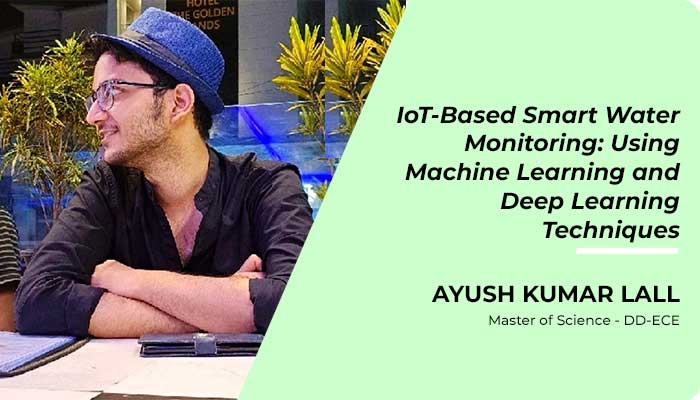Ayush Kumar Lall, supervised by Dr. Sachin Chaudhari received his Master of Science – Dual Degree in Electronics and Communication Engineering (ECE). Here’s a summary of his research work on IoT-Based Smart Water
Monitoring: Using Machine Learning and Deep Learning Techniques:
The conventional method of manually reading analog meters to track consumption trends is both laborious and costly. Moreover, it falls short in effectively managing sustainable water supplies, necessitating accurate monitoring techniques to provide real-time insights into water usage for consumers. While digital water meters have been introduced, their high cost makes them impractical for widespread adoption, and they lack analytical capabilities for interpreting consumption patterns.
In contrast, traditional analog water meters boast simplicity, low power consumption, durability, and reliability, but they still rely on manual readings, which is inconvenient. To address this issue, an automated data-capturing system is required to transmit real-time meter readings to a cloud server.
Smart water meters, powered by robust ML and DL algorithms for meter reading detection, can analyze the data collected to gain valuable insights into water consumption patterns and detect leaks, facilitating more efficient water management. Ultimately, smart water monitoring devices can empower users to reduce their water usage and contribute to water conservation efforts. Keeping all these aspects in mind, the thesis can be divided into three parts:
Firstly, this thesis introduces an IoT based economic retrofitting setup for digitizing the analog water meters to make them smart. The setup contains a Raspberry-Pi microcontroller and a Pi-camera mounted on top of the analog water meter to take its images. The captured images are then preprocessed to estimate readings using a ML model. The employed ML algorithm is trained on a rich dataset that includes digits from the images of water meters captured by the hardware setup for ten days. The readings are posted on a cloud server in real-time using Raspberry-Pi. High temporal resolution plots of flow rate and volume are generated to derive inferences. The collected data can be used for deriving water consumption patterns and fault detection for efficient water management.
After that, the thesis proposes a DL-based algorithm which is used for improving the performance of digit detection from IoT-based analog water meters. The DL algorithm is trained on a rich dataset of over 160,000 images collected from six water nodes deployed at locations with different environmental conditions. A detailed comparison between the proposed DL and ML algorithm is made based on detection accuracy, feature analysis, error analysis, and computational complexity analysis. It is observed that compared to the ML model, the proposed DL model maintained a higher detection accuracy and is more generalized in terms of feature extraction, which makes the algorithm robust.
Finally, the thesis presents a comprehensive analysis of water supply behaviour on an educational campus, focusing on two distinct regions: student hostels and faculty/staff quarters. The investigation delves into the impact of water supply patterns on a monthly and weekly basis. Notably, it highlights how each month, with its unique characteristics such as holidays, exams, and class schedules, influences the water supply in both regions. One key difference between the two regions is that students reside in one, leading to significant variations in water usage based on the number of holidays. Conversely, the other region accommodates families, resulting in a consistent water requirement regardless of college holidays.
The findings from this analysis are crucial for understanding water distribution patterns, particularly within IWS systems, with the ultimate goal of enhancing the efficiency and robustness of water distribution. By thoroughly examining the water supply behaviour in an educational campus and considering various factors that influence it, this work contributes to a better understanding of water management on campus.
January 2024

